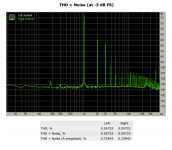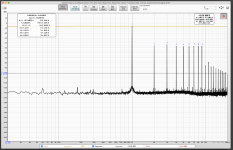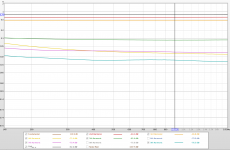XRK
This is a cool How-To. REW is super strong, I just use it to measure the impedance and calculate T/S parameters of speakers. Actually, John (the author of REW)helps me a lot.
I've already had a USB soundcard.
I'm wondering the resistor in your circuit should be non-inductive?
My speakers are 4ohms or 2ohms, what value should I choose for the resistor in your circuit?
Sorry for the late response. I haven’t visited this thread in a while and don’t have notifications turned on.
I now use non inductive resistors. The EBG UXP-350 power resistors are excellent and perfect for high power loads as you can attach a heat sink to them. The distortion was measurably less when using an EBG non inductive flat planar film resistor vs a wire wound one.
EBG Resistors, manufacturer of high voltage, power thick film resistors
If you speaker presents a 2ohm load, you should measure at 2ohms. You may need to parallel a 4ohm load.
Other choices are Dale CMF55 or other high quality Metal thin film built up as series parallel. So a 25 resistor series parallel can handle 12.5w load. Be reasonably cost effective and low inductance. You can get any value load you want. If you use a 1W Metal thin film resistor, it’s good for 25w. Enough to test most amps at a higher power.
The EBG UXP’s are good for hundreds of watts with a CPU cooler and fan.
There are some older 300W EBGs on eBay:
Any screenshots for comparison? Thanks.
Measured at @19.9V/50W
Frequency/THD plot is pretty much the same as RMAA, but RTA showing much higher THD. I start thinking it is because the amp has high current choke CCS, so hysteresis due to continuous 1K tone of RTA may cause the difference.
Please let me know what you guys think.
Attachments
Last edited:
The schematics is here:
https://www.diyaudio.com/forums/pass-labs/357180-sit-50w-single-amp-beta-4.html#post6296943
https://www.diyaudio.com/forums/pass-labs/357180-sit-50w-single-amp-beta-4.html#post6296943
xrk971, is this the answer for my question? I wonder why sound card output does matter? I think it's better to use one box AD/DA because their clock is almost perfectly synced together, means less jitter.
I can generate sine wave from the other software in the same computer...
PS: I'll check simple AD/DA loop now. (Only a cable between DA and AD).
I can generate sine wave from the other software in the same computer...
PS: I'll check simple AD/DA loop now. (Only a cable between DA and AD).
Last edited:
I have issues in a simple loopback test.
Every several seconds (but randomly) the test signal crackles somehow and the the measurement gets obviously very bad.
I tried many things, like higher latency, but I never succeeded.
With ARTA, I do not have any such issues.
Could it be that REW is pretty CPU hungry?
My PC is old, has an AMD Athlon 5050e dual core processor, 8GB of RAM, SSD and a dedicated graphic modern NVIDIA card.
Soundcard is ESI Juli@ with ASIO (PCI).
So, despite most of the components are up to date, the processor is not.
Maybe this is an explanation, why using an independent source gives better results?
Every several seconds (but randomly) the test signal crackles somehow and the the measurement gets obviously very bad.
I tried many things, like higher latency, but I never succeeded.
With ARTA, I do not have any such issues.
Could it be that REW is pretty CPU hungry?
My PC is old, has an AMD Athlon 5050e dual core processor, 8GB of RAM, SSD and a dedicated graphic modern NVIDIA card.
Soundcard is ESI Juli@ with ASIO (PCI).
So, despite most of the components are up to date, the processor is not.
Maybe this is an explanation, why using an independent source gives better results?
A quick question if I may. Would it be feasible to record tones from a DAC into a PCM recorder via XLR for example and then download the PCM files to a PC and analyse them offline with REW? Or am I being stupid?
The recorder is question would be the Tascam DR-100MKIII that uses the AKM AK4558 ADC chip.
Thanks!
This can work but realize it will be limited by whatever DAC and ADC are in the recorder. So do a loop back test of the recorder using a low distortion test tone. The AK4458 is a good DAC and similar to one used in my DAP. For a while I used my DAP as the external source playing a high res flac of a 1kHz tone. Ultimately, I found the DAP with AK4490(?) the limiting factor and switch to an Akitika 2ppm. I later tried Victor’s low distortion source (powered by 4x 9v batteries in series) and got even better results. At these low levels of distortions, battery power makes a difference. You have to disconnect from mains where possible and grounding is very important.
I have issues in a simple loopback test.
Every several seconds (but randomly) the test signal crackles somehow and the the measurement gets obviously very bad.
This sounds like an interupt issue - or something making periodic spurious noise. Try running your laptop on battery power vs wall plug. I have noticed this happens sometimes when there is a large source of noise present.
Measured at @19.9V/50W
Frequency/THD plot is pretty much the same as RMAA, but RTA showing much higher THD. I start thinking it is because the amp has high current choke CCS, so hysteresis due to continuous 1K tone of RTA may cause the difference.
Please let me know what you guys think.
Wihh RTA and my soundcards, -6 dBFS is just to much.
-14 is good
EMU 0404
I resurrected an old EMU 0404 USB which had gathered dust ever since EMU stopped supporting the drivers on anything beyond Windows XP.
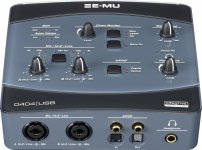
I discovered an actively maintained macOS driver here: GitHub - Wouter1/EMU-driver: OSX Kernel extension for Creative Labs EMU driver and since I have moved to a Macbook Pro as my main computer, that was a pleasent surprise.
The REW calibration tool yielded some not so bad results, so I am happy to begin some amp testing with this as my audio interface.
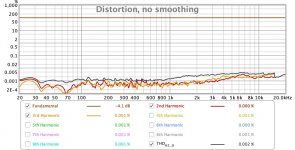
I resurrected an old EMU 0404 USB which had gathered dust ever since EMU stopped supporting the drivers on anything beyond Windows XP.

I discovered an actively maintained macOS driver here: GitHub - Wouter1/EMU-driver: OSX Kernel extension for Creative Labs EMU driver and since I have moved to a Macbook Pro as my main computer, that was a pleasent surprise.
The REW calibration tool yielded some not so bad results, so I am happy to begin some amp testing with this as my audio interface.

Thanks for this suggestion.
Doing this definitely helped but didn't completely remove the problem for me. i could only set to 2048 (the upper limit).
But I'm using ASIO4ALL (with a Sound Blaster SB1240) if that makes a difference.
mlloyd1
Doing this definitely helped but didn't completely remove the problem for me. i could only set to 2048 (the upper limit).
But I'm using ASIO4ALL (with a Sound Blaster SB1240) if that makes a difference.
mlloyd1
I had same issue with decent CPU (i5-4460). Increase ASIO buffer size and cracks will be gone.
It's all depend on computer performance, sampling rate and FFT length.
Although FFT computational complexity is O(N log N) compared to DFT's O(N^2) it is still very processor intensive task.
Those dropouts occur when CPU can't keep up with computing FFT, managing OS processes and sending data in same time.
Sometimes things like bloated OS or poor drivers can severely affect this performance.
Usually device ASIO drivers are better than universal ASIO4ALL.
In contrast to working with DAW low latency isn't really required during measurements. So we can sacrifice latency and increase buffer size to reduce CPU load.
Although FFT computational complexity is O(N log N) compared to DFT's O(N^2) it is still very processor intensive task.
Those dropouts occur when CPU can't keep up with computing FFT, managing OS processes and sending data in same time.
Sometimes things like bloated OS or poor drivers can severely affect this performance.
Usually device ASIO drivers are better than universal ASIO4ALL.
In contrast to working with DAW low latency isn't really required during measurements. So we can sacrifice latency and increase buffer size to reduce CPU load.
- Home
- Design & Build
- Software Tools
- How to - Distortion Measurements with REW
